Displaying Collectable Athletic Jerseys:
Where-in I explore how to go about displaying the numbers in the manner they deserve.
I am selling more and more jersey cases. Not all of them are for jerseys though. Some are for simple T shirts that folks are proud of -they were wearing them at a special occasion or event. Goodness knows -anything that anyone has ever dreamed-up -or wanted to sell- or thought was funny- has been silk-screened on a T-shirt at some point. (Not sure what to make of a world that seems to do most of it's communicating on their chests and/or car bumpers.)
Clothing is easy enough to display -you just tack it up, But displaying it well and dramatically, well, this is quite another kettle of fish. Think about window dressers. These people dress windows for big department stores and are phenomenally creative, paid very well, work very hard at it, and have all manner of tools and materials at hand. They do their work so well, in fact, that you (or someone you may love) and people of like tastes, spend 20% of this countries money of clothes, cosmetics, and accoutrement.
I am not foolish enough to comment on this situation, nor am I going to suggest that I have any of these skills myself. It occurs to me that I might, however, be like the guy in the background that makes the stuff that make the window dresser look so good. My case work is perhaps the first step to displaying clothing -and like it or not, sports jerseys are clothing. But this is just the first step. Let me offer you some advice on making your sports stuff POP.
Perhaps just a few words are appropriate on selecting a case for a given jersey. First, I'd bear in mind that they are bigger then you might think. Athletes are not usually small people, and any piece of clothing -when spread out flat- is bigger then the body it is designed to cover. Here is what to do: Simply spread it out on a bed and measure it. I measure things all day, and am pretty good at judging dimensions, but it seems that my eye can only do so for wood. Don't seem to be near as accurate with fabric. USE A TAPE MEASURE before you go out and buy your display case, one of mine or someone else's.
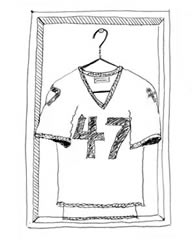 EASIEST POSSIBLE APPROACH:
EASIEST POSSIBLE APPROACH:
You stick a single push pin at the top of the case, and hang the jersey on a wire clothes hanger and hang this on the push pin. Done
A LITTLE MORE EFFORT: 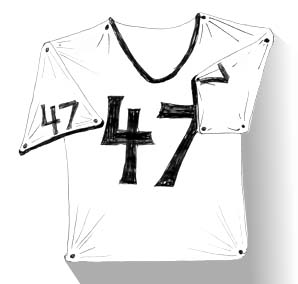
You lay the case down flat, arrange the jersey in an artful or dramatic fashion, and stick a few thumb tacks in at strategic points. Or you can use double-stick tape. But double stick tape will eventually fail, the jersey will drop to the bottom of the case, and it will have an ugly schmootz of dried-out tape adhesive permanently gooed into the fabric of the jersey.
AND WITH JUST A LITTLE MORE EFFORT:
You make a form fitting cut-out to put inside the jersey and then attach the jersey to the case on little blocks. This way, it sort of "floats" a half inch or so off the back of the case. This is an easy way to make an impressive display -it will look like a real collectable. Here is what you do:
#1. Begin by spreading your jersey out on the bed and measuring it. It is apt to be bigger then you might have thought.
#2. Next, go out and buy yourself a good sized sheet of foam-core. Buy yourself two sheets because you might mess up the first one and it's reasonably cheap. Foam-core is a layer of plastic foam-stuff with two nice layers of cardboard on both sides. The foam is in the core -hence the name. It's available in 1/8 inch or 1/4 inch thicknesses and in black or white. White being easier to find. (Actually, it's available in lots of colors and thick nesses if you are willing to find it and pay for it. Look in the phone-book for either plastic (sheet) suppliers or sign making material suppliers.) It depends on how big a jersey you are working with, but you might be able to find 36" x 48" pieces at the office supply store in white and 1/4 inch thick.
#3. One of the nice things about foam-core is that it is easy to cut. All you need to do is to arrange the jersey (again) on the sheet, trace around it, and cut it with a box knife or a single edge razor. Take you time here and do your cutting on something besides your bed -or the kitchen table, unless you don't value either. If you don't get all carried away, a carpeted floor makes a reasonably good cutting board, but don't cut deeper then you have to. I'd not worry about making it smaller they your tracing. The jersey will stretch. You might find that you need to put the jersey on and take it off, and re-cut a time or two to get things just right. You might also end up glad you bought a second sheet.
#4. If you are of an artistic bent -or have access to one -and let's be honest here -such a person is apt to be a woman -you might consider doing an articulated kind of a thing. This is to say, you might want to make a big flat doll out of foam core and pose the jersey. My skills run more toward wood and power tools then they do fabric and so I will respectfully -to those who can make fabric do nice things- cease trying to offer advise in this direction.
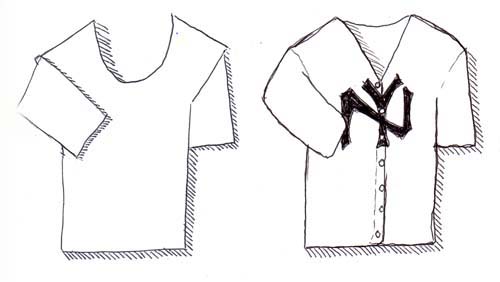
#5. Makes no never-mind if you stretched your jersey on a single sheet of foam-core, or made an articulated 'doll' and posed it all, the nest step is to make it look like it's floating in the middle of the case. You will need some little softwood blocks -pine or cedar or something. These will act as spacers to hold the jersey off the back of the case. They don't need to be bigger then an inch or two square and 3/4 inch thick, but it's not critical. If you don't have such a handy thing as a woodworker at hand, it's no big deal. Cut 12 -15 pieces of foam-core about two inches square. You are going to make little blocks with 3 or 4 pieces of foam-core layered together. The thickness of your blocks -the number of pieces you use- will, of course, depend on the thickness of your jersey and the depth of your display case. Might be a good time to use the old tape measure again. Don't forget the thickness of the jersey and its seams and letters etc. In general, you want the jersey "floating" about midway between the case-back and the underside of the glass or acrylic window. Sandwich them all together with white glue. Use big books or cans of soup and hold them down till the glue dries. Might not hurt to use a little wax paper of something if you have been a little generous with the glue.
#6. Once you have your little spacer blocks done, you can either hot-glue then to the back of the case (either the foam-core laminations you made or wood blocks) or screw them to the case through the back, (wooden blocks, and be sure to countersink the screws carefully). At this point, you probably want to hang it on the wall. This is a critical art that I explain in excruciating detail -'cause it's important damn-it- in my article The RIGHT Way to Hang Things on the Wall. Now that your case is correctly attached to the wall, and the blocks are in place, it's a relatively simple matter to use thumb tacks to attach the jersey cum foam-core cut-out form to the blocks. You simply slip you hand under the from of the jersey and push the thumb-tack through the foam-core and the back of the jersey into your blocks. Might be helpful to have an extra pair of hands about now. And if one pair of the other were feminine, it might be more better to let the feminine -and I presume smaller- hands do the slipping under and thumb tacking. Additionally, if his hands are anything like mine, (and I have to say that my hands do beautiful things with tools and wood), I'd let her do it because I'd also have to say that my hands are spectacularly inept with fabric. Enough said.
AN ELEGANT APPROACH THAT IS NOT ALL THAT DIFFICULT:
What we are going to do here is stick a pipe through the case -from side to side, and hang our jersey off the pipe. This is particularly good if it's a football jersey. These things have to go over shoulder pads and so they wind up about 4 feet wide, -never mind the fact that they are sized to go over football players who are -themselves- about 4 feet wide. With the pipe in place, the jersey can be artfully bunched up a little and still show the numbers etc.
The doing is simplicity itself. You go to the home-center store and get a piece of copper pipe -1/2 inch or 3/4, and a little steel-wool -OOO of OOOO would be about right. If need be, they can probably cut it at the store too, but a hack saw will do the job if you don't have a tubing cutter. If you don't have car wax or furniture paste wax at home, pick some up to. You then polish the pipe and wax it. And it will polish up beautifully. Don't be discouraged by the way it looks in the rack at the store. (If you can find it, brass pipe is perhaps more elegant.) Wax it immediately after you polish it, and if you are careful not to touch it with your fingers before the wax dries, it will stay shiny (pretty-much) forever.
You probably want to decide where to drill the holes through the sides of the case with the case, pipe and jersey all in place. Then it's a simple matter to drill the appropriate holes. Measure carefully and either back up the hole with a sacrificial scrap of wood, or start the hole from one side and finish from the other side. Slide the pipe in a little, stick it in one arm hole and out the other and then stick it out through the other hole in the case. Done.
MUSEUM-LIKE PROFESSIONALISM:
To be perfectly honest -the last word is to put the thing on a dummy or manikin -or wax figure that is made to look like your sports hero. But if you want to go this extreme, you are out of my league -and just a little bit scary!
But if you are only a little obsessive on the issue -this is the best way to display a piece of clothing. It's a pain in the tuchas, but the curatorial result is truly impressive.
What you are going to do is make an "armature." This is a wire frame that holds things up. Sculptors start their work with armatures, or those that work in clay do anyway. Dick Blick* has some of the stuff, but you can find it at a well stocked art supply store. What it is, is thick aluminum wire. It's pretty stiff and supportive, but not so stiff that you can't bend it with your hands -or pliers if you need a tight curve and have kind of a weak grip. It comes in various gauges, (diameters) up to 5.2 mm -0.2 inches. Get the thickest you can find. 10 feet will run you about $8.00.
The only tricky bit is to attach it to the inside of the display case. It has to be a RIDGED attachment or the whole thing will flop about and fall out when ever you open the case.
Here is what to do. You will need a block of wood, a drill and bit that matched the size of your armature. Drill a pair of holes through the thickness of the block as shown. Then drill one through the center of the block length-wise. Have a look at the drawing. Then you cut the thing up to make two little armature holders you will screw to the inside of the sides of the case. Do not try to get by with a single hole -you really have to pin it down and make it ridged. The only way to do this is with a sharp bend and two slots. There are many different ways to make these slots and holders. If you have a woodworker handy, let him or her pick their own methods. Paint them black -or to match the inside of your cases. Don't forget the screw holes you will use to mount it. I like 1 1/4" drywall screws for such things. And they come in black.

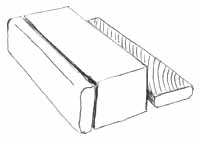
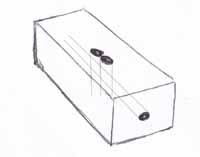
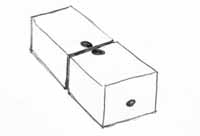
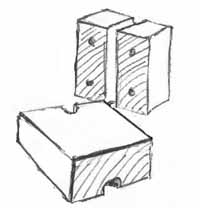
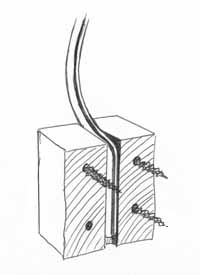
I'm afraid I don't have a lot of advice for you on how to form your armature to your specific jersey. Simplest is to go up one arm, across the shoulders, down the other arm and out the other sleeve. But you can get creative and pose the jersey in an athletic way. Be creative. You might, for example, go up one sleeve, down the other, out the cuff and into the front of the shirt and out the bottom, like in the drawing. Bear in mind though, that if you bend any wire back and forth often enough -it will break.

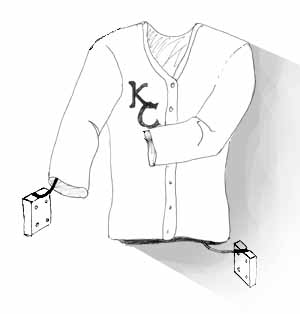
As a final touch, you might consider doing something to thicken up the armature. Think of putting paper towel rolls over the wire to give the shoulders a little heft -rather then just hanging limply on the wire like a clothes hanger vs. the hangers they give you when you buy a nice jacket. You might find yourself making rolls for the shoulder, upper arm, lower arm etc. A little careful cutting, bending and taping or gluing might be appropriate. But be careful with the any old tape. If your collectable jersey is truly collectable, you need to give some thought to avoiding acid and other materials that would do bad things to the fabric. Unbleached paper or cardboard is better in this matter then the pristine white paper that has been soaked in bleach. To really do it right, cover it al in unbleached muslin. Have a look at my article on curatorial materials and fabric in A Visit to the Fabric Store.
A FEW LAST WORDS:
As a final step -before you close the door and admire your work, you might want to include some miscellany or souvenirs in the case with the jersey. The jersey will certainly be the centerpiece of your work, but balls, bats, ticket-stubs, bubble-gum cards, or certainly a picture would be appropriate. Lots of ways to do this. I offer advice in this directions in Shadow Boxes.
Finally, remember that if it's valuable and if it's wool, you owe it to posterity to add moth balls somewhere. Check out my articles on Bio-Hazards as well as Light Damage. The sun fades dyes in collectable athletic jerseys as well as it fades your regular clothes. Hang it in the darkest corner of the room.
* If you are a creative sort of a person, and have some money burring a hole in you pocket -I PROMISE you that you will find something you can't live without at Dick Blick Art Supplies.
© 2005 Bill Harvey